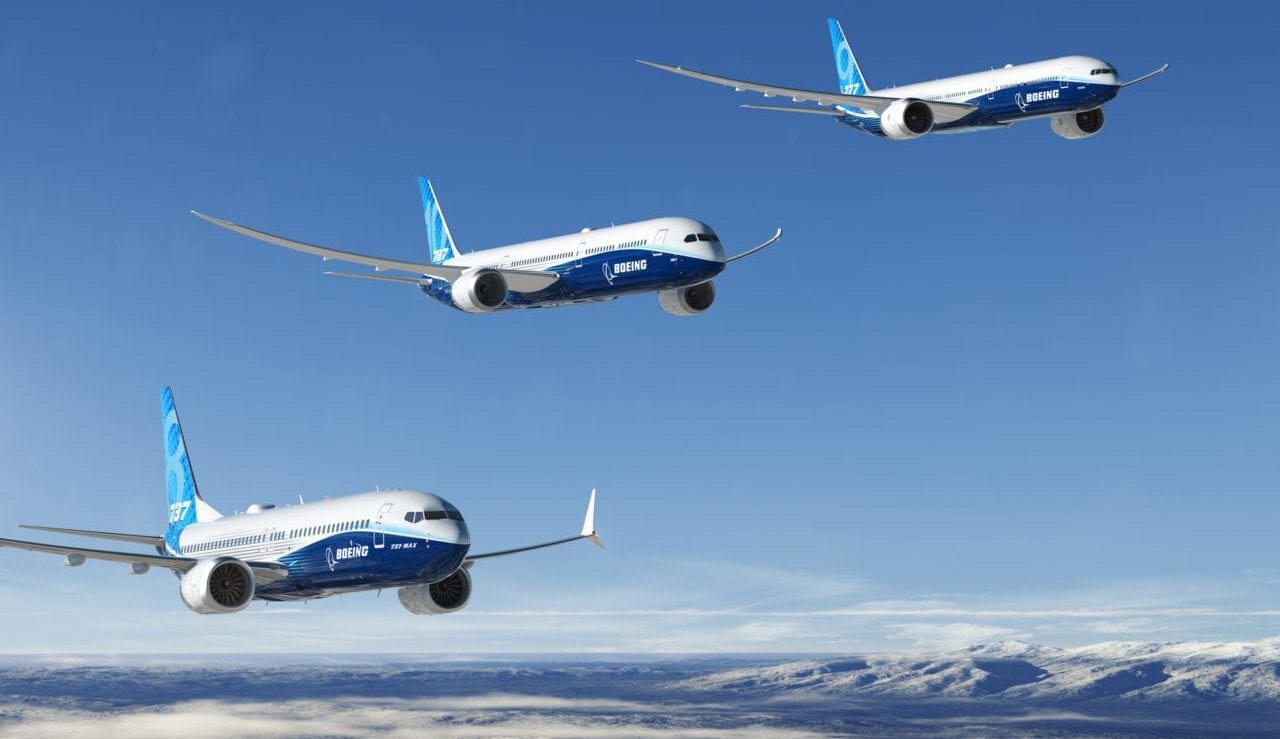
A Boeing 737 MAX, 777 and 787 Dreamliner flying together. (Boeing)
Boeing CEO Dennis Muilenburg doesn’t blame the airlines that are clamoring for compensation after the grounding of the 737 MAX — he said it’s the plan.
“We’re working with individual customers,” Muilenburg said at Bernstein’s 35th annual Strategic Decisions Conference Wednesday morning. “Obviously, our customers’ fleet schedules have been interrupted by the MAX, and we regret that. We know we’ve impacted the summer schedules for many of them, and it’s difficult, it’s painful.”
Boeing has a number of different ways to make restitution, according to its chief executive. The delivery interruption has changed what some operators want, so the company is shifting plans around: some airlines want to receive planes sooner once the MAX is back in the sky to ramp back up flight operations, while others want to push their deliveries back.
In other cases, Boeing is offering value in the form of service and training support or other “currencies” that it can trade with customers. “In some cases, cash may be a part of the solution,” Muilenburg said. “They have been impacted by the MAX being down, and we’re going to work with each and every one of them to get them back up and running.”
When that does happen — Muilenburg couldn’t provide a specific timeline but said gaining approval to return to service was “near-term work” — the company will treat it as an entry-into-service event. He said each aircraft will get individual attention from Boeing field teams before they’re back in the sky.
“We’re hoping for broad international alignment with FAA,” Muilenburg said, but noted that some international authorities may elect to follow their own schedules. Questions brought up by the FAA’s oversight of the 737 MAX’s certification, which the agency is currently investigating, have led to some mistrust at home and abroad.
If the examination of the use of organization designation authorizations (the FAA mechanism by which Boeing was able to largely self-certify the MAX with federal oversight), or Boeing’s separate investigation into the process finds any ways to improve the process, Muilenburg said, that will have downstream impacts on Boeing’s other products, too.
“I don’t see anything there right now that will alter the timeline for the 777X, but it’s possible we will see something that will alter the content of the test program or how we go about certification and training,” he said.

The 777X final body join. (Boeing)
While Boeing is prioritizing the MAX “when it comes to resources, talent, people,” that hasn’t shifted expected timelines for anything else yet. The company still expects a 2020 entry into service for the 777X and currently has the first two aircraft of that line performing integrated system tests in preparation for flight testing.
The much-anticipated new mid-market aircraft (NMA) is also still seen “as a 2025 entry into service kind of airplane,” if the company goes forward with it — the plan is to offer a decision this year and an authority to launch a decision next year. Boeing continues to work on the business case for the NMA in parallel with the MAX, “but it’s very clear to us that our top priority is getting the MAX back up flying safely and the NMA is second to that,” Muilenburg said.
That sentiment also applies to the 737 MAX’s production ramp-up; Boeing will worry about it once the narrow-body is back in the air. That said, Muilenburg expects to ultimately return to the originally planned rate increase to get the 737 MAX up to 57 units per month and existing demand indicates that another rate increase could make sense as well.
Regardless of Boeing’s decision on the NMA, the manufacturer’s biggest investments will be in research & development, Muilenburg said, particularly in terms of manufacturing and design technologies — the digitization of its future supply chain, increased automation and other ways to optimize the manufacturing process to make it more efficient. As an example of the dividends that bears, digital assembly allows Boeing to bring TX Trainer joint assembly down “from days to about an hour,” letting the company bid for the contract more aggressively.
That digital move extends to its nascent, but growing, services business. Muilenburg said with the 777X, Boeing is starting to think about how the strategy affects airplane architecture, designing the aircraft for digital services downstream.
With massive projected growth in the aviation industry over the coming decades, Boeing sees opportunity, but its leadership knows it can’t seize on that if it can’t first regain the trust it lost through its issues with the 737 MAX.
The trust of the flying public has been hurt, and it will take time for us to re-earn that confidence. “The long-term prospect of our business counts on people’s confidence in the safety of flying,” Muilenburg said. “I see this as a defining moment.”